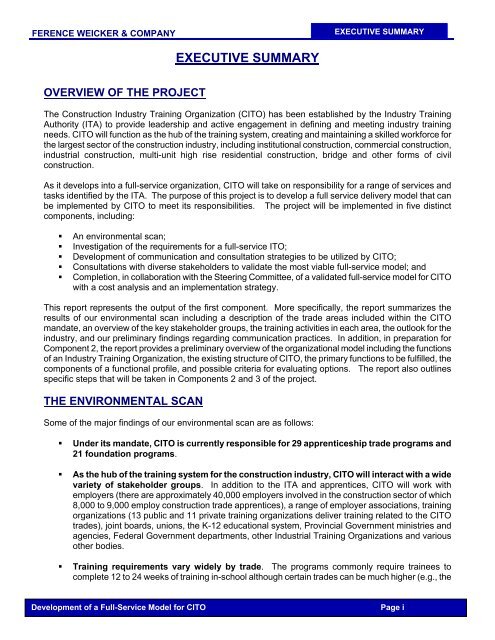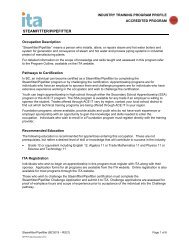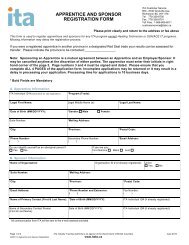CITO - Phase I Report - Industry Training Authority
CITO - Phase I Report - Industry Training Authority
CITO - Phase I Report - Industry Training Authority
You also want an ePaper? Increase the reach of your titles
YUMPU automatically turns print PDFs into web optimized ePapers that Google loves.
FERENCE WEICKER & COMPANY<br />
OVERVIEW OF THE PROJECT<br />
EXECUTIVE SUMMARY<br />
EXECUTIVE SUMMARY<br />
The Construction <strong>Industry</strong> <strong>Training</strong> Organization (<strong>CITO</strong>) has been established by the <strong>Industry</strong> <strong>Training</strong><br />
<strong>Authority</strong> (ITA) to provide leadership and active engagement in defining and meeting industry training<br />
needs. <strong>CITO</strong> will function as the hub of the training system, creating and maintaining a skilled workforce for<br />
the largest sector of the construction industry, including institutional construction, commercial construction,<br />
industrial construction, multi-unit high rise residential construction, bridge and other forms of civil<br />
construction.<br />
As it develops into a full-service organization, <strong>CITO</strong> will take on responsibility for a range of services and<br />
tasks identified by the ITA. The purpose of this project is to develop a full service delivery model that can<br />
be implemented by <strong>CITO</strong> to meet its responsibilities. The project will be implemented in five distinct<br />
components, including:<br />
� An environmental scan;<br />
� Investigation of the requirements for a full-service ITO;<br />
� Development of communication and consultation strategies to be utilized by <strong>CITO</strong>;<br />
� Consultations with diverse stakeholders to validate the most viable full-service model; and<br />
� Completion, in collaboration with the Steering Committee, of a validated full-service model for <strong>CITO</strong><br />
with a cost analysis and an implementation strategy.<br />
This report represents the output of the first component. More specifically, the report summarizes the<br />
results of our environmental scan including a description of the trade areas included within the <strong>CITO</strong><br />
mandate, an overview of the key stakeholder groups, the training activities in each area, the outlook for the<br />
industry, and our preliminary findings regarding communication practices. In addition, in preparation for<br />
Component 2, the report provides a preliminary overview of the organizational model including the functions<br />
of an <strong>Industry</strong> <strong>Training</strong> Organization, the existing structure of <strong>CITO</strong>, the primary functions to be fulfilled, the<br />
components of a functional profile, and possible criteria for evaluating options. The report also outlines<br />
specific steps that will be taken in Components 2 and 3 of the project.<br />
THE ENVIRONMENTAL SCAN<br />
Some of the major findings of our environmental scan are as follows:<br />
� Under its mandate, <strong>CITO</strong> is currently responsible for 29 apprenticeship trade programs and<br />
21 foundation programs.<br />
� As the hub of the training system for the construction industry, <strong>CITO</strong> will interact with a wide<br />
variety of stakeholder groups. In addition to the ITA and apprentices, <strong>CITO</strong> will work with<br />
employers (there are approximately 40,000 employers involved in the construction sector of which<br />
8,000 to 9,000 employ construction trade apprentices), a range of employer associations, training<br />
organizations (13 public and 11 private training organizations deliver training related to the <strong>CITO</strong><br />
trades), joint boards, unions, the K-12 educational system, Provincial Government ministries and<br />
agencies, Federal Government departments, other Industrial <strong>Training</strong> Organizations and various<br />
other bodies.<br />
� <strong>Training</strong> requirements vary widely by trade. The programs commonly require trainees to<br />
complete 12 to 24 weeks of training in-school although certain trades can be much higher (e.g., the<br />
Development of a Full-Service Model for <strong>CITO</strong> Page i












